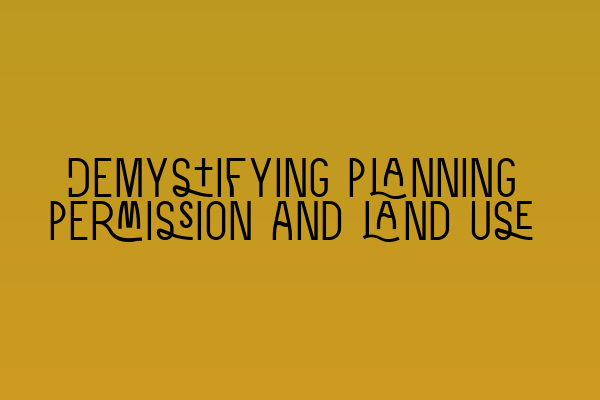Demystifying Planning Permission and Land Use
Planning permission and land use are two critical aspects of property law that can often be confusing and overwhelming. Whether you are a property owner, developer, or investor, understanding the intricacies of planning permission and land use is essential for successful real estate ventures.
In this article, we will demystify the complexities surrounding planning permission and land use, providing you with a comprehensive overview and actionable insights.
What is Planning Permission?
Planning permission is essentially the consent that is required from local authorities before you can carry out certain types of development on a piece of land or property. It is a legal requirement in most cases and is aimed at ensuring that development is in line with overall planning policies and objectives.
Obtaining planning permission involves submitting an application to the relevant planning authority, which will thoroughly assess the proposed development against various factors, including environmental impact, traffic management, impact on neighboring properties, and adherence to local planning policies.
It is important to note that planning permission is not a one-size-fits-all process. The type of permission you will need depends on the nature and scale of the development you plan to undertake. For example, small-scale projects such as home extensions may fall under permitted development rights, while larger-scale developments may require more extensive scrutiny.
The Importance of Land Use
Land use is a critical consideration in the planning permission process. It refers to the specific purpose or activity for which a piece of land or property is designated. Common land uses include residential, commercial, agricultural, and industrial. Understanding land use regulations is crucial as it dictates what types of development are permitted in specific areas.
The planning authority will carefully assess how a proposed development aligns with the existing land use designation in the area. For example, if you are looking to build a residential property in an area designated for commercial use, it is unlikely that your application will be granted.
It is worth mentioning that land use designations are not set in stone and can be subject to change through the local planning process. This means that as a property owner or developer, you can potentially seek to have the land use designation altered to accommodate your proposed development. However, this is often a complex and lengthy process that requires thorough evidence and strong justifications.
The Planning Permission Process
The planning permission process typically involves several stages, including:
- Pre-application: Before submitting a planning application, it is often advisable to engage in pre-application discussions with the local planning authority. This helps you understand the specific requirements, policies, and potential concerns related to your proposed development.
- Application submission: Once you have gathered all the necessary documentation and information, you can formally submit your planning application. This typically includes detailed plans, design drawings, impact assessments, and any relevant reports or surveys.
- Assessment and consultation: The planning authority will thoroughly assess your application, considering factors such as impact on the local environment, compliance with planning policies, and input from various internal and external consultees. This may include consultations with the local community, relevant agencies, and experts.
- Decision: Based on the assessment and consultation process, the planning authority will make a decision regarding your application. This decision can either be a grant of planning permission, refusal, or request for additional information or modifications to the proposal.
- Appeals: If your application is refused, you have the right to appeal the decision to the Planning Inspectorate. The appeals process involves providing additional evidence and arguments to support your case.
Common Misconceptions
There are several misconceptions surrounding planning permission and land use that are important to address:
- Assuming permitted development rights cover all changes: Permitted development rights do provide certain flexibilities for small-scale projects, but it is crucial to thoroughly research and understand the specific limitations and conditions that apply. Some projects may still require planning permission.
- Ignoring environmental impact considerations: Environmental impact is a substantial factor in planning permission. Ignoring or downplaying the potential impact of your proposed development can lead to the refusal of planning permission.
- Not engaging with the local community: Local communities often have a say in the planning process. Neglecting to engage with the community or address their concerns can hinder the success of your planning application.
Conclusion
Navigating the planning permission and land use process can be complex, but with proper understanding and guidance, it can become more manageable. By recognizing the importance of planning permission, understanding land use designations, and following the correct procedures, you can increase the likelihood of obtaining planning permission for your proposed developments.
If you need further assistance or have any questions regarding planning permission and land use, our team at SQE Property Law & Land Law is here to help. Contact us today to discuss your specific requirements and ensure a smooth and successful planning process.
Related Articles:
